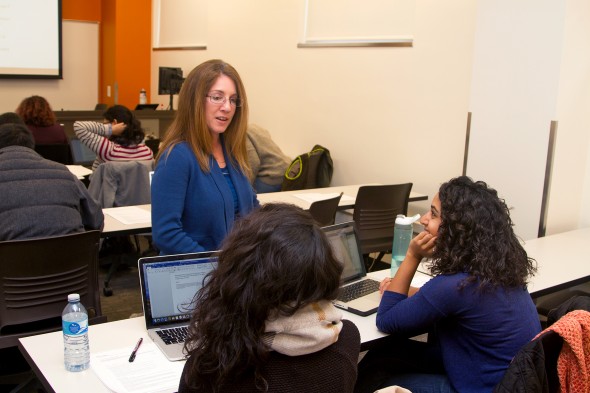East Meets West: Public health, urban planning team up

Public health researcher Jamie Chriqui studies the relationship between community environment and physical activity. (Photo: Vibhu S. Rangavasan)
When Jamie Chriqui set out to study the relationship between community environments and physical activity, she knew a different approach and a cross-disciplinary perspective would be needed.
“From the beginning, we had a clear focus and knew that a specific kind of expertise was needed to pull off this project,” said Chriqui, professor of health policy and administration in the UIC School of Public Health and co-director of the Health Policy Center in the UIC Institute for Health Research and Policy.
We asked, ‘What makes the most sense for the study?’ The answer was not extensive clinical health care experience. It was support from individuals who had an interest in urban planning and a background in understanding the nuances of municipal zoning.”
That’s why she hired UIC students from the College of Urban Planning and Public Affairs to help her compile and analyze county and municipal codes of more than 4,000 U.S. jurisdictions in an effort to understand the link between zoning policies and public health.
Working with CUPPA students on this study was a perfect fit, Chriqui said.
“The students I worked with had the right background to understand the various policies and codes. This project also gave them an opportunity to get involved in a research project that really complemented their courses in a unique way,” said Chriqui, who is also an IHRP Fellow.
The study was funded by the National Cancer Institute and was one of the first in the nation to look at community-level land use to see how zoning can facilitate or inhibit structural changes in the environment that could, in turn, lead to increased physical activity among adults. Regular physical activity is one of the most important things individuals can do to maintain and improve health. However, only one in five Americans meet the activity guidelines recommended by the U.S. government.
“This study was a bridge between public health and urban planning,” said Sunny Bhatt, one of seven students from CUPPA who worked on the study. “It was particularly interesting to me because I’ve always had an interest in zoning policy and grassroots community activism efforts around sustainability and walkability.”
Bhatt, who was a first-year master’s degree student in the Urban Planning and Policy degree program when the study began, said the work was fascinating, although not very glamorous.
“We spent eight hours a day reviewing the zoning codes from every kind of municipality you can imagine — from large urban areas to small rural communities,” said Bhatt, a 2013 graduate with a master’s in urban planning who is now a city planner and zoning specialist for the city of New York and its five boroughs.
As a first step, graduate-level CUPPA students collected the zoning codes from the largest 472 U.S. counties and municipalities located in those counties. Under the direction of Chriqui and Emily Thrun — a 2011 master’s in urban planning graduate and an urban planner who helped develop and oversee the project’s collection and coding efforts — students like Bhatt analyzed the codes.
They were looking for the presence and strength of specific environmental markers related to physical activity. Environmental markers included sidewalks, active recreation areas and mixed-use developments, for example.
Chriqui, Thrun and the team developed an evaluation tool that linked the zoning code data to reported data on physical activity and active living. Their findings showed the potential of zoning code reform to support physical activity and improve health.
According to the Centers for Disease Control and Prevention, people who are physically active tend to live longer and have a lower risk for heart disease, stroke, type 2 diabetes, depression and cancer.
Chriqui and her team have published seven groundbreaking articles.
Robin Mermelstein, director of the IHRP, says that the zoning code research is a perfect example of why multidisciplinary collaboration is necessary when it comes to many of the most pressing public health issues.
“Our health is impacted by so many factors,” Mermelstein said. “To understand how communities affect individual health, we first needed to have experts who understand how communities are planned and sustained. Dr. Chriquí’s research with urban planners and urban planning students is a great example of how working together can make significant progress toward reducing health disparities.”
